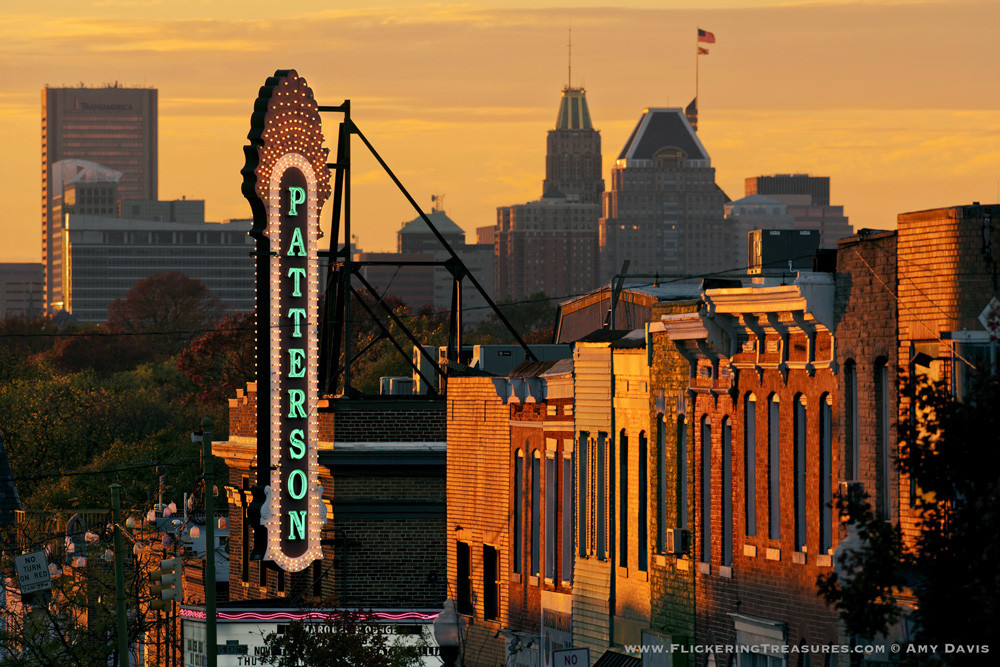Here we are on a late summer evening at the newly refurbished Parkway Theatre, North Avenue and Charles Street, at a party celebrating Amy Davis’ new book on vanished, old Baltimore movie palaces. Everybody’s naturally swapping stories about happy times they used to have all over town in the dark.
Ah, remember The Ambassador, they say. And they recall seeing Elvis Presley’s big breakout movie there. Or remember The Forest, they say, when Saturday afternoons meant horror films that kept you sleepless for weeks at a time.
Or Carlin’s Drive-In, John Waters was saying now. Waters, Baltimore’s comic bad boy of cinema, was like everybody else, standing in line in the Parkway lobby to get a copy of Davis’ gorgeous book, “Flickering Treasures: Rediscovering Baltimore’s Forgotten Movie Theaters,” published by the Johns Hopkins University Press, and recalling his best moment.
“Carlin’s Drive-In,” he said, looking a little bit proud. “Got arrested there. They took me away in handcuffs. Underage drinking.”
Already typecasting himself.
Everybody’s got cherished memories of movie-going. In Davis’ book, the pictures of the old theaters, in their former glory and in their current decay, and the shared recollections, will take you back to yesteryear.
Today’s kids will find this hard to believe but Baltimore in the middle of the last century had 119 theaters. The city’s down to a handful now. The old Uptown and Forest theaters became churches. The Crest is now the Motor Vehicle Administration. The Ambassador looks as if it’s been hit by a meteor. But long ago, it seemed as if every neighborhood had its own glittery palace.
Follow their demise and you follow the simultaneous rise of the infant called television. Who needed to leave the house for laughs when post-war TV had Uncle Miltie and Sgt. Bilko and Sid Caesar? Also, follow the closing of theaters and follow the changing fates of their surrounding neighborhoods.
“The chasm between the past and present can be very painful,” writes Davis, a veteran photographer with The Sun. “Our most disfigured and forgotten theaters are metaphors for a city that has fallen short of its promise.”
“Flickering Treasures” mixes dreamy photos with memories both poignant and hilarious. Here’s former Mayor Tommy D’Alesandro III sharing a comic tale with Davis: “I had my eye on this girl. Finally I got a date, [but] I didn’t have a car, so I traveled by trolley down Eastern Avenue. … All I had was a $20 bill. The fare was 10 cents. (The conductor) gave me $19.90 back in nickels. They were weighing my pockets down.
“I was trying to make an impression with this girl, but the nickels were falling out of my pockets. When I bent down to get a nickel, more nickels would fall out. When we finally got to the Hippodrome … I sat down and money started to fall down into the seats. Every time the girl looked in my direction, I was on the floor collecting the nickels.”
Here’s Academy Award-winning director Barry Levinson, recalling Saturday afternoons in his youth at the Gwynn Theatre on Liberty Heights Avenue, when “sometimes we went next door to Ben Franklin’s, which was sort of a five-and-dime store, and we’d load up with peashooters and bags of peas.
“When we lost interest in the film, we could just shoot peas at one another in the dark. We’d hide behind the chairs or crawl along the aisles – it was 8-year-old warfare.”
When my family lived in East Baltimore, I’d go to the Apollo Theatre on Harford Road, just below North Avenue. Years later, when I was writing a daily newspaper column, I found myself outside the old place working on a story when a couple of young neighborhood fellows approached me.
“Paper?” one of them asked.
I thought he’d recognized my face from my newspaper photo. This felt pretty good — returning to my childhood hangout and getting recognized by a new generation. But I wasn’t sure.
“Newspaper?” I asked.
“Sheet,” he replied. “I’m talkin’ about reefer paper.”
Now there’s a theatrical moment to get high on.
A former Baltimore Sun columnist and WJZ-TV commentator, Michael Olesker is the author of six books. His most recent, “Front Stoops in the Fifties: Baltimore Legends Come of Age,” has just been re-issued in paperback by the Johns Hopkins University Press.
Top photo: The Patterson: 3134 Eastern Avenue, 2013, from “Flickering Treasures: Rediscovering Baltimore’s Forgotten Movie Theaters” © Amy Davis 2017





